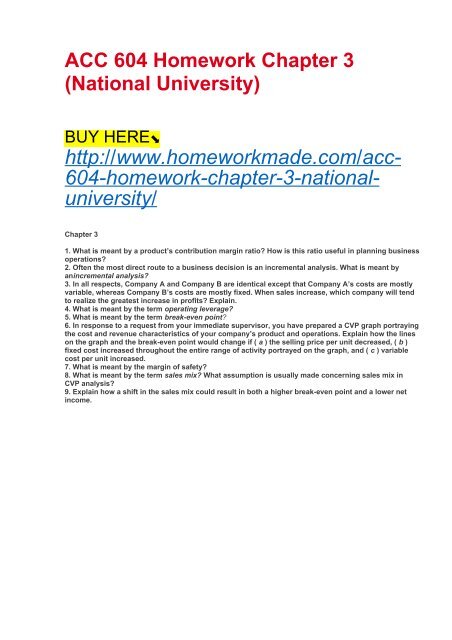ACC 604 Homework Chapter 3 (National University)
- No tags were found...
You also want an ePaper? Increase the reach of your titles
YUMPU automatically turns print PDFs into web optimized ePapers that Google loves.
<strong>ACC</strong> <strong>604</strong> <strong>Homework</strong> <strong>Chapter</strong> 3<br />
(<strong>National</strong> <strong>University</strong>)<br />
BUY HERE⬊<br />
http://www.homeworkmade.com/acc-<br />
<strong>604</strong>-homework-chapter-3-nationaluniversity/<br />
<strong>Chapter</strong> 3<br />
1. What is meant by a product’s contribution margin ratio? How is this ratio useful in planning business<br />
operations?<br />
2. Often the most direct route to a business decision is an incremental analysis. What is meant by<br />
anincremental analysis?<br />
3. In all respects, Company A and Company B are identical except that Company A’s costs are mostly<br />
variable, whereas Company B’s costs are mostly fixed. When sales increase, which company will tend<br />
to realize the greatest increase in profits? Explain.<br />
4. What is meant by the term operating leverage?<br />
5. What is meant by the term break-even point?<br />
6. In response to a request from your immediate supervisor, you have prepared a CVP graph portraying<br />
the cost and revenue characteristics of your company’s product and operations. Explain how the lines<br />
on the graph and the break-even point would change if ( a ) the selling price per unit decreased, ( b )<br />
fixed cost increased throughout the entire range of activity portrayed on the graph, and ( c ) variable<br />
cost per unit increased.<br />
7. What is meant by the margin of safety?<br />
8. What is meant by the term sales mix? What assumption is usually made concerning sales mix in<br />
CVP analysis?<br />
9. Explain how a shift in the sales mix could result in both a higher break-even point and a lower net<br />
income.

















